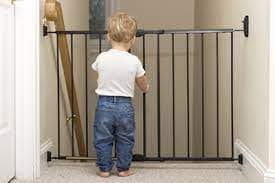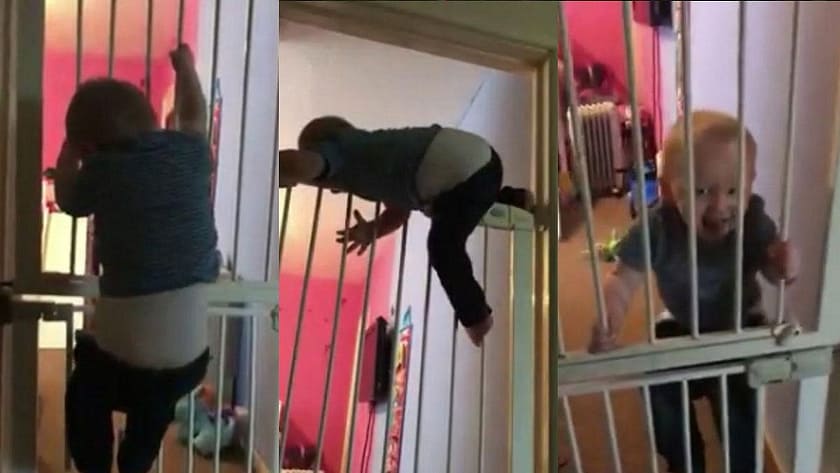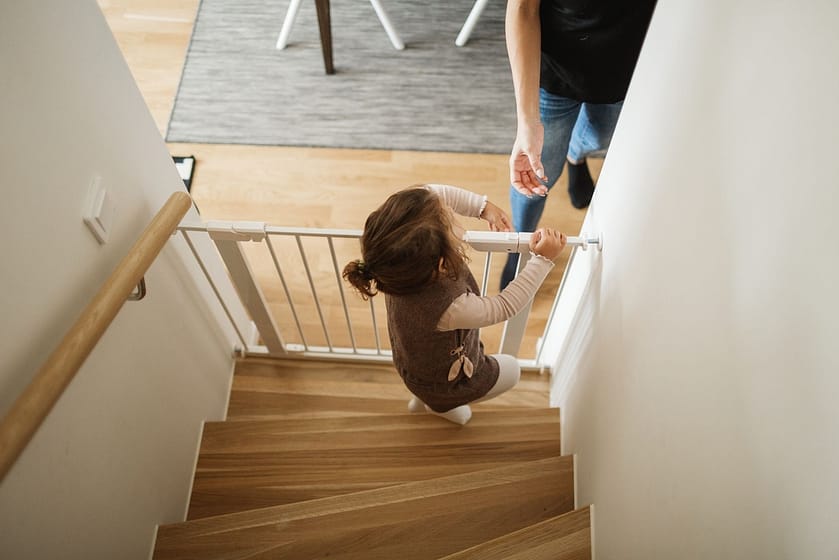Table of Contents
ToggleBaby gates are an essential tool in ensuring the safety of our little ones as they start to explore the world around them. These barriers offer parents peace of mind, creating a safe environment by blocking access to potentially dangerous areas like stairs.
However, a question that often perplexes many parents is, “When can baby gates come down?” This question is not as straightforward as it might seem, as it depends on a variety of factors such as the child’s mobility, curiosity, and understanding of safety.
In the following sections, we will delve deeper into these aspects to provide a comprehensive answer to this all-important question.
Short Answer "When Can Baby Gates Come Down?"

Baby gates can typically come down once your child is around two to three years old and demonstrates a clear understanding of safety rules and the ability to navigate stairs independently.
However, it’s important to note that all children develop at different rates and some may need the gate longer for safety.
Therefore, it is always crucial to consider your child’s individual development and the layout of your home before determining when to remove the baby gates.
When is the Right Time to Take Down Baby Gates and Which Risks Are Involved?
The right time to take down baby gates is often determined by the child’s ability to safely navigate stairs and understand the potential risks involved.
If your child can ascend and descend the stairs without assistance and has a good comprehension of safety rules, it might be time to consider removing the baby gates.
However, always observe your child’s behavior and confidence around stairs before making this decision.
Risks Involved
- Risk of Falls: Even if your child can navigate stairs independently, there is always a risk of accidental falls, especially if they are prone to running or roughhousing.
- Risk of Unsupervised Exploration: Without a baby gate, your child has more freedom to explore. This can lead to them wandering into areas of the home that might not be child-proofed.
- Risk of Injury from Household Items: The absence of baby gates can expose your child to household items that might cause injury, such as kitchen utensils or cleaning products.
- Risk of Other Hazards: If your home has other potential hazards, like a fireplace or a balcony, removing the baby gate could put your child at risk.
Always remember, each child and home environment is unique. What works for one family might not work for another, so it’s important to evaluate the risks carefully.

According to a guide from Do Baby Gates Expire, there are several clear signs that your child may be ready for the baby gates to be taken down.
These signs include their ability to use the stairs safely, their understanding of safety instructions, and even their height in relation to the gate.
However, the guide stresses the importance of not rushing this process and considering all potential hazards in your home before making the decision.
It’s crucial to remember that the well-being of your child is always paramount, and the baby gates can remain until you are confident in their safety without them.
Understanding the Developmental Milestones of Babies to Assess if it’s Safe to Remove Baby Gates:
Understanding your child’s developmental milestones is key to assessing their readiness to navigate spaces without the safety of baby gates.
- Mobility: By the age of 2-3 years, most children are able to climb stairs independently, some even without holding onto the railing. This is an important milestone that indicates their physical readiness to move around without baby gates.
- Understanding of Safety Rules: Another crucial factor is your child’s ability to comprehend and follow safety rules. Can they understand and remember instructions like “Do not go into the kitchen alone” or “Stay away from the fireplace”?
- Impulse Control: Children around the age of 3 start developing impulse control. If your child can resist the urge to engage in potentially dangerous activities, like climbing over furniture or running down the stairs, it’s a positive sign that they might be ready to have the baby gates removed.
- Judgment: Lastly, your child’s judgment plays a crucial role. If they can identify risky situations and make safe decisions, such as not trying to pick up a sharp object, it’s a good indicator of their readiness for a gate-free environment.
Remember, these are guidelines and actual development can vary from child to child. Always consider your child’s individual development and behavior before making the decision.
How Can You Be Proactive in Making Sure Your Home is Safe for a Toddler Without Baby Gates?

With baby gates out of the picture, you need to ensure your home remains a safe environment for your toddler. Here are some steps you can take for a toddler-friendly home:
- Childproof Your Home: The first step is to childproof your home. Make sure all cleaning supplies, medications, and other potentially harmful substances are kept high up or locked away. Cover electrical outlets and secure heavy furniture to prevent it from tipping over.
- Secure Dangerous Areas: If there are specific areas or rooms with potential hazards, use door locks or high handles to keep them out of reach. This includes rooms with tools, exercise equipment, or pets.
- Teach Safety Rules: Regularly remind your toddler about safety rules and encourage them to abide by them. This could include not climbing furniture, staying away from the stove, and not touching sharp objects.
- Create a Safe Play Area: Designate a specific area in your home as a safe play area. This should be free of sharp objects, choking hazards, and other potential dangers.
- Regular Supervision: While giving your child some independence is important, regular supervision is essential for their safety. Keep an eye out for their activities, especially when they’re near potential hazards.
Remember, the transition from using baby gates to a gate-free environment is a big step for both you and your little one. By taking these measures, you can make this phase as safe and stress-free as possible.
For more comprehensive information on when to remove baby gates, considering factors such as your child’s developmental milestones and safety measures for a house without baby gates, you can refer to this detailed article on When to Remove Baby Gates.
Creative Alternatives to Traditional Baby Gates and How They Can Keep Babies Safe?
Alternative 1: Use Baby Playpens
Baby playpens work as a confined play area, keeping your child safe while allowing them to move around and play. They are portable and can be placed wherever necessary. It’s an excellent alternative, especially for those moments when you need to do tasks that require your attention like cooking, cleaning, or working.
Alternative 2: Install Door Knob Covers
Door knob covers are easy to install and prevent babies and toddlers from opening doors. This solution can restrict access to potentially dangerous areas like kitchens, bathrooms, or basements, eliminating the need for gates across multiple doorways.
Alternative 3: Use Dutch Doors
Dutch doors, doors that split in half, allow the top section to be opened while the bottom remains closed, creating a barrier for your child. They offer an aesthetically pleasing and practical alternative to traditional baby gates.
Alternative 4: Consider a Scare Stair
A ‘Scare Stair’ is a single, over-sized step placed at the top or bottom of your stairs. Its size and height make it difficult for toddlers to climb, effectively deterring them from using the stairs unsupervised.
Alternative 5: Try Furniture Arrangement
A strategic arrangement of furniture can also create a natural barrier. Large items like sofas, tables, or bookcases can be positioned to block access to certain areas. This solution requires no installation and can be adjusted to suit changes in your living space.
Remember, each alternative has its own pros and cons. It’s essential to consider your child’s developmental stage and the layout of your home before choosing an alternative to baby gates.
Things To Consider Before You Decide If It’s Time To Remove Those Baby Gates:
Deciding when to remove baby gates is a crucial decision for any parent or guardian. Here are some key considerations you should keep in mind:
- Child’s Developmental Stage: Evaluate your child’s developmental stage thoroughly. Can they comprehend safety instructions? Are they able to control their impulses and make safe decisions? These are important factors to consider before deciding to remove baby gates.
- Safety of the Home: Has your home been childproofed? Are all potentially dangerous items and substances out of reach? Making sure your home is safe should be a top priority.
- Child’s Independence: How independent is your child? If they can navigate around the house safely and understand the importance of staying away from danger, this might be a sign they’re ready.
- Presence of Potential Hazards: Consider the potential hazards in your household. If there are dangerous areas or objects accessible, it might be best to keep the baby gates a little longer.
- Supervision: Are you or another adult able to constantly supervise the child? While it’s important to allow them some independence, constant supervision is essential to ensure safety, especially immediately after removing the baby gates.
- Alternative Safety Measures: If you decide to remove the baby gates, have you considered alternative safety measures like door knob covers, baby playpens, or a strategic furniture arrangement? These can provide additional safety.
Remember, every child’s development is unique, and there is no fixed timeline for when baby gates should be removed. The safety and well-being of your child should always come first.
What safety measures should be taken once baby gates are no longer needed?
Once you decide to remove baby gates from your home, it is crucial to implement additional safety measures to maintain a secure environment for your child. Here are some key points to consider:
- Continuous Supervision: Even without baby gates, your child will still need constant supervision. Always stay vigilant, particularly when they are near stairs or potential hazards.
- Safe Play Area: Ensure your child has a safe play area where they can enjoy their time without any risks. This area should be free of sharp objects, choking hazards, and other potential dangers.
- Regular Safety Checks: Regularly inspect your home for potential dangers, such as loose carpets or rugs, unsecured furniture, or accessible cleaning supplies. Act immediately to eliminate any risks you find.
- Safety Locks: Install safety locks on cabinets containing harmful substances, such as cleaning supplies or medicine. Additionally, use safety locks on windows and balcony doors to prevent your child from venturing out unsupervised.
- Fire Safety: Install smoke detectors in all bedrooms and on every level of your home. Regularly check the batteries and functionality of these detectors to ensure they are in good working order.
- Stove and Oven Safety: Use stove knob covers to prevent your toddler from turning the stove or oven on. Also, always turn the pot handles toward the back of the stove to prevent hot spills.
By following these safety measures, you can ensure that your home remains a safe place for your child to explore and grow, even after baby gates are no longer needed.
Conclusion:
In conclusion, the decision to remove baby gates is a significant one that depends on various factors such as your child’s developmental stage, the safety of your home, and your ability to provide constant supervision. Remember, there isn’t a fixed timeline – each child’s readiness can differ.
If you do choose to remove the gates, make sure to implement additional safety measures to maintain a secure environment.
This includes ensuring a safe play area, conducting regular safety checks, installing safety locks, and paying attention to fire safety and stove safety. Ultimately, the safety and well-being of your child are paramount.
Each step taken, be it the installation or removal of baby gates, should be in the best interest of your child’s safety and independence.


1 thought on “When Can Baby Gates Come Down? Essential Tips from the Experts”